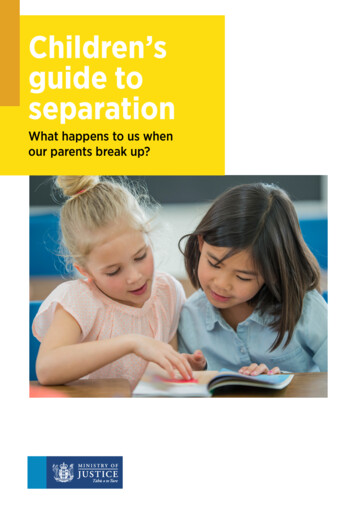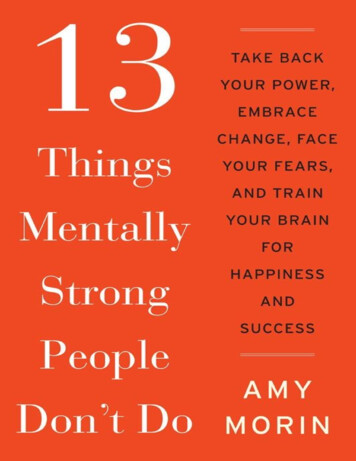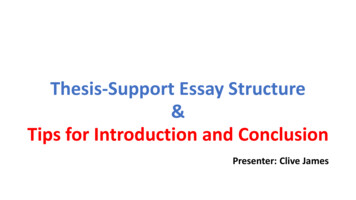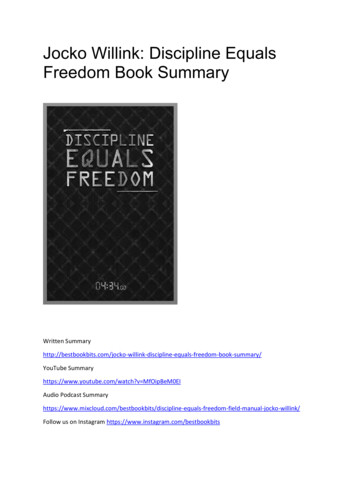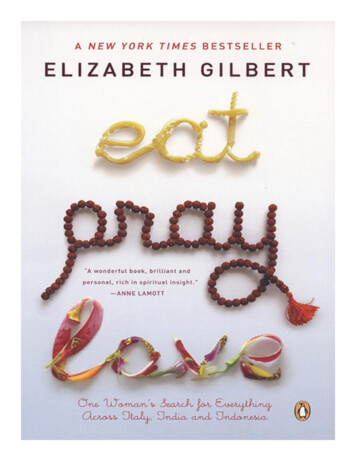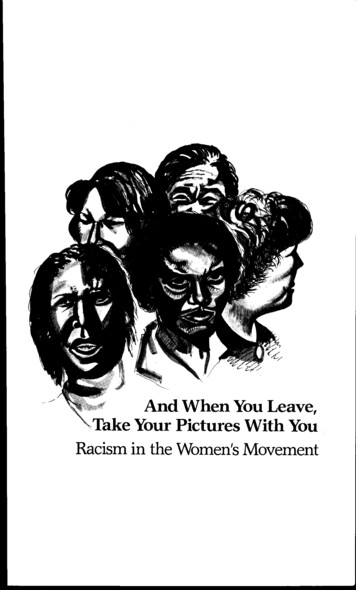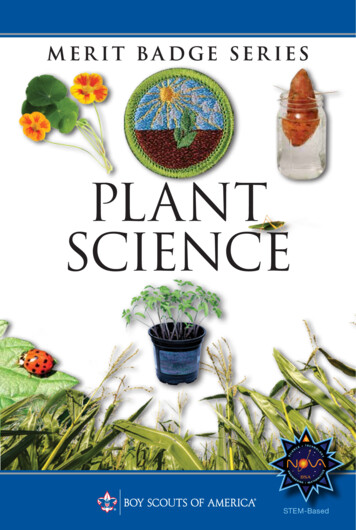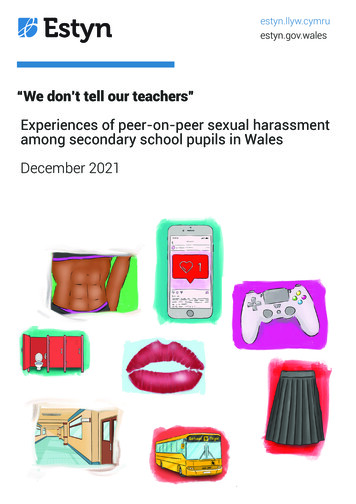
Transcription
estyn.llyw.cymruestyn.gov.wales“We don’t tell our teachers”Experiences of peer-on-peer sexual harassmentamong secondary school pupils in WalesDecember 2021
The purpose of Estyn is to inspect quality and standards in education andtraining in Wales. Estyn is responsible for inspecting: nursery schools and settings that are maintained by, or receive funding from,local authorities primary schools secondary schools special schools pupil referral units all-age schools independent schools further education independent specialist colleges adult learning in the community partnerships local government education services teacher education and training Welsh for adults work-based learning learning in the justice sectorEstyn also: reports to Senedd Cymru and provides advice on quality and standards ineducation and training in Wales to the Welsh Government and others makes public good practice based on inspection evidenceEvery possible care has been taken to ensure that the information in this document isaccurate at the time of going to press. Any enquiries or comments regarding thisdocument/publication should be addressed to:Publication SectionEstynAnchor CourtKeen RoadCardiffCF24 5JW or by email to publications@estyn.gov.walesThis and other Estyn publications are available on our website: www.estyn.gov.walesThis report is also available in Welsh. Crown Copyright 2021: This report may be re-used free of charge in anyformat or medium provided that it is re-used accurately and not used in amisleading context. The material must be acknowledged as Crown copyrightand the title of the document/publication specified.
ContentsPageIntroduction1Background4Main findings7PupilsSchoolsLocal authorities7810Recommendations11What pupils told us – findings from pupil focus group activities andonline questionnaire13Pupils’ understanding of peer-on-peer sexual harassmentPeer-on-peer sexual harassment in schoolSchool uniform and the sexualisation of girlsOnline sexual harassmentWhy pupils don’t tell their teachers about sexual harassment and wherethey go to for supportYoung people’s views and experience of personal ad social educationWhat pupils want their schools to knowWhat pupils want their schools to do1314161720Provision and leadership in secondary schools28The culture of safeguarding in schoolsCare, support and guidanceThe curriculumLeadershipThe support schools need2831354143Why young people don’t tell their teachers about peer-on-peer sexualharassment, and why schools do not know the extent of the problem45Appendix 1: Methodology47Appendix 2: Definitions and glossary49Appendix 3: References51232426
‘We don’t tell our teachers’– experiences of peer-on-peer sexual harassment among secondary schoolpupils in WalesIntroductionThis report considers the incidence of peer-on-peer sexual harassment in the lives ofsecondary-aged young people and reviews the culture and processes that helpprotect and support young people in secondary schools in Wales. Sexual harassmentoccurs when a person engages in unwanted conduct of a sexual nature that has thepurpose or effect of: violating someone’s dignity; or creating an intimidating, hostile, degrading, humiliating or offensive environmentfor themSexual harassment is unlawful under the Equality Act 2010. In our work with pupils,we defined peer-on-peer sexual harassment as: making sexual comments, remarks, jokes either face-to face or online lifting up skirts or taking a picture under a person’s clothing without them knowing making nasty comments about someone’s body, gender, sexuality or looks tocause them humiliation, distress or alarm image-based abuse, such as sharing a nude/semi-nude photo or video withoutthe consent of the person pictured sending unwanted sexual, explicit or pornographic photographs/videos tosomeoneThe report was written in response to a request from the Minister for Education inJune 2021. This review is of relevance to learners, parents and schools as well as tothe Welsh Government, statutory services and third sector organisations directlyinvolved with children and young people.The report includes a review of existing guidance and support for schools and otherrelevant agencies who work directly with children and young people. It highlights howeffective schools develop and maintain a strong safeguarding culture that promotesrespect and the importance of healthy, positive relationships. The report shares howstrong leadership and proactive approaches encourage and empower pupils to trusttheir teachers, stand up to their peers, and report all forms of sexual harassment.This report also explains the shortcomings which impact negatively on pupils’wellbeing.The report highlights both effective practice and shortcomings seen by inspectorsduring school visits. The report will be of particular importance to schools as theyprepare for their delivery of their Health and Wellbeing Area of Learning Experience(AOLE) as part of Curriculum for Wales. This is because relationships and sexualityeducation (RSE) will become a mandatory part of the curriculum for all pupils fromthe age of 3 in primary schools from September 2022 and for Years 7 and 8 insecondary schools, either from September 2022 or September 2023 If schools wishto delay its roll out.1
‘We don’t tell our teachers’– experiences of peer-on-peer sexual harassment among secondary schoolpupils in WalesThe review focuses on secondary-aged pupils only. We visited 35 schools in total, ofwhich 27 were maintained secondary schools, two were maintained all-age schoolsand six were independent schools. We were accompanied by inspectors from CareInspectorate Wales (CIW) to three of the independent schools with boardingprovision.We visited at least one secondary school in every local authority in Wales. Where alocal authority had more than nine secondary schools, we visited a second school. Inaddition, we selected a proportionate number of schools named on the Everyone’sInvited 1 website where pupils or former pupils have shared testimonies of personalexperience of peer-on-peer sexual harassment. Our sample included Welsh-mediumschools and faith schools.The report summarises findings from pupil focus group activities. Inspectors haddirect discussions with secondary-aged learners in interactive workshops. Pupils whotook part in the workshops engaged in open discussions and completed a carefullyplanned work booklet about their experiences and understanding of peer-on-peersexual harassment. Throughout this report, we have used direct quotes from pupilsand, as a result, the report contains words and phrases that readers might findupsetting.The report also provides a summary and analysis of a questionnaire that pupils wereasked to complete as part of the focus group activities. Inspectors spoke to schoolstaff about the provision for personal and social education (PSE), includingrelationships and sexuality education (RSE). We also asked staff about the natureand prevalence of peer-on-peer sexual harassment and how schools manage this.We visited schools between 27 September and 8 October 2021. This was during aperiod of very high numbers of COVID-19 cases amongst school children and schoolstaff across Wales. We had arranged to engage with 1,600 pupils through our visitsbut, due to the high number of absences, we worked with around 1,300 pupils. Weare extremely grateful to school staff and pupils for their support and collaborationduring a challenging time. All headteachers responded positively to our request fortheir school to take part in this work as they all agreed that dealing with peer-on-peersexual harassment is an important issue.We engaged with several relevant external stakeholders (please see Appendix 1).We also conducted interviews with officers from a minority of local authorities acrossWales. We wish to acknowledge the support Professor EJ Renold, Cardiff University,gave prior to and during the co-creation of the focus group booklet. We are grateful toProfessor Renold for their permission to publish the tutor and pupil focus groupbooklets in this report for school use. We are also grateful to Professor Renold andcolleagues from the Children’s Commissioner’s Office and NSPCC Wales for thebespoke training they provided to inspectors prior to conducting school visits.1The website Everyone’s Invited was also used to inform this report. This website was created as asafe space for people to discuss their experiences regarding rape culture and sexual violence. Thewebsite released the names of schools mentioned in the testimonies of survivors to expose theprevalence of rape culture.2
‘We don’t tell our teachers’– experiences of peer-on-peer sexual harassment among secondary schoolpupils in WalesWe have published a Supporting Resources document alongside this report, whichcontains details of Welsh Government guidance, findings from research and usefulresources for schools. In addition, the Supporting Resources includes the full findingsof the pupil focus group activities, the full analysis of the pupil questionnaire and thepupil and tutor focus group booklets.3
‘We don’t tell our teachers’– experiences of peer-on-peer sexual harassment among secondary schoolpupils in WalesBackgroundYoung people, the Welsh Government and many organisations have publicly sharedtheir concern about the alleged prevalence of peer-on-peer sexual harassmentamong children and young people in Wales. Pupils tell us that this is happening faceto-face during school hours, but they also state that this is happening more onlineand after school.Peer-on-peer sexual harassment, including online sexual harassment, is a societalissue that is also prevalent in adult life. The number of adults, in particular women,who have experienced some form of sexual harassment in a public space or online isextremely high, especially amongst 18 to 24-year-olds. A recent report on the‘Prevalence and reporting of sexual harassment in public places’ by the All-PartyParliamentary Group for UN Women UK (2021) found that 71% of women of all agesin the UK have experienced some form of sexual harassment in a public space. Asmany as 86% of 18 to 24-year-old women said they have experienced sexualharassment. However, the number of women who reported the incident to the policeis alarmingly low. The two main reasons women of all ages gave for not reportingincidents are:I didn’t think the incident was serious enough to report (55%) andI didn’t think reporting it would help’ (45%) (APPG for UN Women UK, 2021, p.6).However, 44% of women agreed that if reporting the incident would prevent it fromhappening again, they would be encouraged to report it.Since June 2020, the anti-rape online community movement ‘Everyone’s Invited’(n.d.) has invited survivors of rape and sexual harassment to share their stories onthe website with the aim of exposing rape culture through conversation, education,and support. Over 15,000 anonymous testimonies have been submitted and sharedon the website. At the time of planning this work, the website included testimoniesfrom pupils or ex-pupils about alleged peer-on-peer sexual harassment in 84education providers in Wales. The schools named include mainstream secondaryand independent schools and a very few primary schools and further educationcolleges. The website also includes testimonies from pupils in providers of furtherand higher education in Wales.Support for reform and change in attitudes towards sexual harassment and abuse,particularly towards girls and women, has grown considerably over the last threeyears through activities by organisations such as the ‘Me Too’ movement’ (2021) (Asocial movement against sexual abuse and sexual harassment where individualspublicise allegations of sexual crimes. The movement’s aim is to empower victims tobreak silence and gain empathy and solidarity from others.) However, researchshows that, in many cases, both males and females who experience sexualharassment do not pursue their complaints through the courts.4
‘We don’t tell our teachers’– experiences of peer-on-peer sexual harassment among secondary schoolpupils in WalesThrough our work with pupils during school visits, we see that a similar problemexists in secondary schools 2. Pupils do not systematically tell their teachers aboutpeer-on-peer sexual harassment. This is for a number of reasons: Young people feel that peer-on-peer sexual harassment has become normalisedand almost expected. Their behaviours and attitudes are significantly influenced by what they seehappening on social media. Children and young people turn more to the internet for support and guidancerather than talking with parents or other adults. Pupils say that teachers do not take peer-on-peer sexual harassment seriouslyenough.Welsh Government policy and guidanceWithin the Curriculum and Assessment (Wales) Act 2021(Senedd Cymru, 2021),the Health and well-being Area of Learning and Experience (Area) will have equalstatus in law to five other areas of the curriculum (Languages, Literacy andCommunication, Mathematics and Numeracy, Science and Technology, Humanities,Expressive Arts). The Curriculum for Wales centres around ‘The Four Purposes’ oraims of the new curriculum. One of these four purposes under section 2(1) of the Actis ‘to enable pupils and children to develop as healthy, confident individuals, ready tolive fulfilling lives as members of society’ (Welsh Government, 2020a). Relationshipsand sexuality education (RSE) will be a mandatory element of the Curriculum forWales for pupils from the age of three onwards in primary schools as well asmaintained nursery schools and non-maintained nursery settings from September2022. Secondary schools who are ready to roll out Curriculum for Wales to pupils inYear 7 may do so from September 2022. However, RSE will not be mandatory until2023 when it will apply to both Year 7 and Year 8 pupils in the first instance. Theproposed draft RSE statutory guidance states:Schools and settings have an important role to play in creating safe andempowering environments that support learners’ rights to enjoy fulfilling,healthy and safe relationships throughout their lives. This is critical to buildinga society which treats others with understanding and empathy, whatever theirethnicity; social economic background; disability; or sex, gender or sexuality.In addition, Section 64 of the Curriculum and Assessment Act (Senedd Cymru, 2021)contains duties for all staff to develop knowledge and understanding of children’shuman rights under the United Nations Convention on the Rights of the Child(UNCRC) and United Nations Convention on the Rights of persons with Disabilities(UNCRPD).The Welsh Government has published several relevant guidance documents tosupport schools in establishing a culture of safeguarding and in promoting theimportance of healthy relationships and positive attitudes towards diversity, including:2Where secondary schools are referenced, we include secondary-aged school pupils in all-ageschools.5
‘We don’t tell our teachers’– experiences of peer-on-peer sexual harassment among secondary schoolpupils in WalesGuidance for education settings on peer sexual abuse, exploitation andharmful sexual behaviour (Welsh Government, 2020b)Sharing nudes and semi-nudes: Responding to incidents and safeguardingchildren and young people – Keeping safe online – Hwb (gov.wales) (WelshGovernment, 2020c)Violence against women, domestic abuse and sexual violence: guidance forgovernors GOV.WALES (2016) (Welsh Government, 2016)Rights, respect, equality: Statutory guidance for governing bodies ofmaintained schools 2019 (Welsh Government, 2019a)We have also published relevant reports on these themes. Specific WelshGovernment departments and specialist support organisations have also createdhelpful resources for schools. A comprehensive list of relevant reports, guidancedocuments and resources are included in Supporting Resources document alongwith brief details of their content. These are all included to help schools plan anddeliver both support and provision for promoting respect, positive relationships anddiversity.6
‘We don’t tell our teachers’– experiences of peer-on-peer sexual harassment among secondary schoolpupils in WalesMain findingsPupils1Around half of all pupils say they have personal experience of peer-on-peer sexualharassment and three quarters of all pupils report seeing other pupils experiencingthis. Nearly all pupils understand how peer-on-peer sexual harassment can have anegative impact on young people’s emotional and mental health.2A majority of female pupils (61%) report having personal experience of peer-on-peerharassment and many (82%) report seeing others experience it. This compares witha lower proportion of male pupils (29% and 71% respectively).3Peer-on-peer sexual harassment is more prevalent online and outside school than inschool. Young people have substantial experience of harassment by their peers viathe mobile phone, social media and gaming sites. This includes:online bullyingposting hurtful comments especially about appearanceasking for, sending and sharing nude or semi-nude photographscatfishingunsolicited friend requests or demands for nude photos by strangers or thosewith a fake social media profile negative attitudes towards girls in digital games 4The most common forms of peer-on-peer sexual harassment during the school dayare pupils catcalling and making hurtful comments, making homophobic comments(mainly towards boys), and comments about appearance.5Generally, pupils do not tell teachers when they experience sexual harassment. Thisis because it happens so regularly, they often either only tell a friend or keep it tothemselves. They feel that it has become normalised behaviour and say thatteachers are not aware of the extent of the problem. In addition, pupils say teachersoften dismiss incidences as trivial or encourage pupils to ignore them. Nearly half ofpupils who said they had experienced sexual harassment from their peers report thatthey kept sexual harassment to themselves.6LGBTQ pupils have substantial personal experiences of verbal homophobicharassment, with many saying that homophobic bullying is happening all the timeand that this is the most common type of harassment in their school.7Many pupils experience the negative impact of peer pressure around expectations ofthe way they should look and the consequent body shaming and bullying if theirbodies do not conform with a certain image of beauty or fitness. Pupils reportparticular issues around the length and fit of the school skirt where girls are bullied byother girls if their skirts are too long and sexually harassed by boys if they are tooshort.7
‘We don’t tell our teachers’– experiences of peer-on-peer sexual harassment among secondary schoolpupils in Wales8A minority of boys speak about being personally involved in sexually harassing theirpeers, including pressurising girls to send nude photographs. Although theyacknowledge that it is wrong, many boys say that sharing nude photographs of girlsamongst their friends and boasting about the number of nude photographs they havein their possession is commonplace.9Many pupils across the whole age range say they have not had enough sex andrelationships education. Older pupils in many schools report that they have had nosex education at all and are very keen for more advice and guidance andopportunities to discuss sex and relationships in a safe and comfortable environment.Many pupils value well-delivered personal and social education lessons but they saythat they do not have enough opportunities to discuss important issues such asrespect, healthy relationships, harmful sexual behaviours and LGBTQ rights. Manysay that they want to see more time given to discuss ‘real life issues’ in school.10Pupils speak highly about presentations by external speakers and experts about sexeducation and healthy relationships. They value having lessons from ‘real life peoplewho talk about real life problems’ and want to see more of this type of learning.Schools11In the most effective schools, leaders promote a strong ethos of respect in all areasof their work. They prioritise wellbeing and adopt a whole-school, proactive approachto promoting and celebrating diversity. In these schools, leaders employ high qualitypastoral staff and set high expectations. Policies, procedures and guidance for staffand pupils link clearly to aims and objectives which ensure that wellbeing is at theforefront of the school’s work.12In many schools, there is a strong team approach to safeguarding. Staff have regularand appropriate training, understand their responsibility with regard to safeguardingchildren and discharge their safeguarding duties well. Normally, leaders respondsuitably to formal complaints by parents or pupils about peer-on-peer sexualharassment and make appropriate referrals to external agencies such as socialservices or the police. The majority of schools use a restorative approach to poorbehaviour, bullying and known cases of harassment and use external agencies wellto support their work. This usually includes providing suitable support such ascounselling for victims.13There is a general inconsistency across school staff about their understanding ofwhat constitutes peer-on-peer sexual harassment including wider issues relating toequality and diversity and how they impact on pupils.14Even within schools, there is inconsistency in the way in which teachers respond toincidences of sexual harassment. In the worst cases, teachers dismiss or ignoreincidences of verbal sexual harassment by pupils towards their peers.15In most schools, leaders, teachers and support staff are unaware of the highprevalence of peer-on-peer sexual harassment amongst young people becausepupils do not systematically tell them about it. There is sharp polarisation betweenwhat pupils say is happening and what staff know. Sexual harassment is a societalproblem that is not exclusive to education settings and schools often deal withproblems that originate from outside of school. Generally, schools respond suitably8
‘We don’t tell our teachers’– experiences of peer-on-peer sexual harassment among secondary schoolpupils in Waleswhen reacting to reported peer-on-peer sexual harassment but are not proactiveenough in their approach to prevent it from taking place. Overall, schools do notprovide enough opportunities for pupils to talk about peer-on-peer sexual harassmentopenly.16In most schools, there are suitable systems and processes for staff to recordconcerns and actions. Generally, staff use such systems regularly, and leadersrespond swiftly to new information. Overall, schools use digital and online systemswell to log incidences of bullying and harassment. Records generally outline thenature of the incident and a narrative of how these issues have developed and areresolved.17Despite the fact that schools generally record behaviour and bullying incidents, theydo not make productive use of the data and information available to them tocategorise and analyse incidences of peer-on-peer bullying and harassment wellenough or identify trends. This hinders schools from having an accurate picture of theextent of different types of bullying and harassment, such as sexual harassment. Inmany cases, schools do not systematically log incidences of sexual harassment and,often, their classification of ‘bullying’ is too broad and does not enable the school torecord and evaluate instances of homophobic, sexist or racially motivated bullying.18Because of the issues detailed above, many leaders do not use information abouttrends in pupil behaviour and the impact of subsequent actions to deal with them toevaluate the effectiveness of their work. In addition, in many schools, leaders do notmake enough use of the findings of the biennial ‘Student Health and WellbeingReport’ (Page et al., 2021) produced by School Health Research Network (SHRN) toplan provision.19In around half of schools, leaders have begun to develop suitable provision for theHealth and Wellbeing Area of Learning Experience (AOLE) (Welsh Government,2020a) of the Curriculum for Wales for one year group, usually Year 7 or Year 8Overall, there is adequate inclusion of topics covering healthy relationships for theseyear groups. In a few schools, leaders ensure appropriate provision for personal andsocial education (PSE) across the whole age range, including for pupils in the sixthform. This provision is a blend of dedicated PSE lessons, assemblies, workshopsand some coverage in other subject lessons.20There is too much variation in the time allocated for PSE across schools in Walesand not enough consideration of the breadth and depth to which PSE topics arecovered as pupils progress through the school. In most schools, largely due to thepressures of the current curriculum, there are no regular PSE lessons for pupils atkey stage 4 or those in the sixth form. The pandemic and remote learning haveimpacted disproportionately on the provision for PSE and provision from externalpartners temporarily stopped during the lockdown periods.21In a small minority of schools, leaders actively elicit pupils’ views on personal andsocial issues, including peer sexual harassment, and respond well to issues as theyemerge or when they are shared by pupils and staff. Examples of strong practiceinclude ‘concerns’ boxes placed in discreet areas, a ‘PSE Suggestions Box’ inclassrooms, older pupil mentors on duty at breaks and a pupil LGBTQ referencegroup which provides advice and support for school leaders on diversity matters.9
‘We don’t tell our teachers’– experiences of peer-on-peer sexual harassment among secondary schoolpupils in Wales22All schools value the support and collaboration of external agencies, such as theschool police officer and youth workers, to supplement their PSE provision. However,schools report that there is now limited external specialist support for sex educationwhich has a negative impact on the wellbeing of many pupils.23All schools say they need more training and support to deliver relationships andsexuality education. This includes whole-school professional learning in how toproactively engage in conversations with pupils about gender issues and sexualharassment. They also require training on LGBTQ issues, for example on how tosupport transitioning or transgender pupils, including through the appropriate use oflanguage or personal pronouns by which they prefer to be addressed.24School staff voice strongly the need for collaboration with parents and for theirco-operation in dealing with incidences of peer-on-peer sexual harassment. Often,these incidences happen online in the evenings and during weekends, but impactpupils’ wellbeing and behaviour during the school day. This collaboration includesregular parental monitoring of children’s use of social media and chat facilities.Local authorities25Under the Welsh Government’s (2019b) Rights, respect, equality: Statutoryguidance, there is a responsibility on local authorities to monitor the termly bullyingand equality data that schools share with them and advise schools on local trends.Schools report few instances of bullying to local authorities and rarely report on peeron-peer sexual harassment. There is a lack of consistency in how local authoritiescollect, analyse and use school bullying and harassment data, for example to planinterventions or staff training.10
‘We don’t tell our teachers’– experiences of peer-on-peer sexual harassment among secondary schoolpupils in WalesRecommendationsSecondary schools should:R1Recognise that peer-on-peer sexual harassment is highly prevalent in thelives of young pupils and adopt a whole-school preventative andproactive approach to dealing with it. This importantly includes providingpupils with assurance that school staff will take every incidence of peer-on-peersexual harassment seriously and work in partnership with parents and externalagencies.R2Provide sufficient, cumulative and beneficial learning opportunities forpupils across the whole age range about healthy relationships, sex andsexuality education. This includes providing a safe, enabling and supportiveenvironment for open and honest discussions.R3Improve the way they record, categorise and analyse incidences ofharassment and bullying. Records should include details about the nature andtype of incidences, the impact on the victim and appropriate actions in responseto both perpetrators and victims. Leaders should ensure they review recordsregularly and evaluate the impact of their actions on pupils’ wellbeing.R4Ensure all school staff receive regular and purposeful professionallearning opportunities on personal and social education matters,including relationships, sexuality, diversity and gender transitioning. Thisis so that they are able to provide an affirmative, proactive approach tosupporting pupils as they grow and develop into young adults.Local authorities should:R5Work with schools to collect and categorise and analyse all bullying andharassment data correctly and comprehensively. In addition, supportschools to analyse this information regularly to identify trends and putrestorative arrangements in place.R6Plan suitable intervention and support on gender issues at both schooland local authority level, evaluating regularly their impact on pupilwellbeing.R7Provide school staff with the necessary professional learning to adopt aproactive approach to peer-on-peer sexual harassment, includinghomophobic, biphobic and transphobic bullying and harassment.The Welsh Government should:R8Work with local authorities to improve the way they collect bullying andharassment information from schools and ensure that local authoritiesidentify and respond to patterns and trends in behaviour. This is in order toplan suitable guidance, training and support for schoo
Peer-on-peer sexual harassment, including online sexual harassment, is a societal issue that is also prevalent in adult life. The number of adults, in particular women, who have experienced some form of sexual harassment in a public space or online is extremely high, especially amongst 18 to 24-year-olds. A recent report on the

